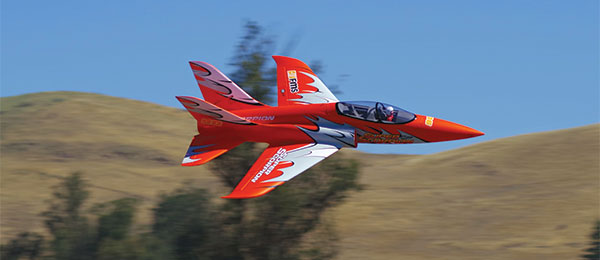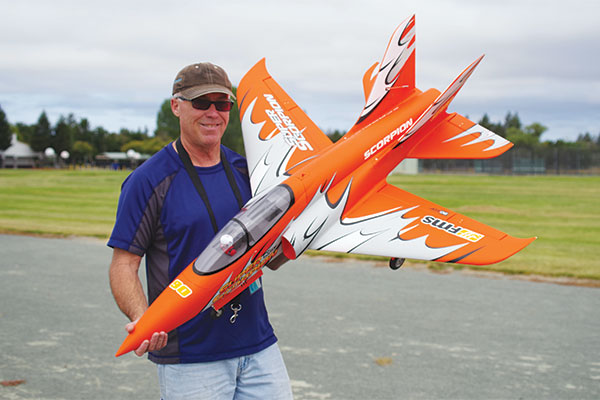FMS 90mm Super Scorpion PNP

Written by Jon Barnes This sport jet stands out Product review As seen in the February 2018 issue of Model Aviation Digital.
Specifications
Model type: EDF jet Skill level: Intermediate Wingspan: 45.20 inches Wing area: 455.7 square inches Length: 52.93 inches Weight: 91 ounces Power system: 90mm EDF Radio: Minimum six-channel recommended Construction: EPO foam Price: $444.99Test-Model Details
Motor used: Predator 3546-1900 Kv brushless outrunner (included) Speed controller: Predator 130-amp with external 10-amp UBEC (included) Battery: 6S 22.2-volt 5,000 mAh LiPo EDF: FMS 12-blade 90mm (included) Radio system: Spektrum DX9 transmitter; Spektrum AR8000 receiver Ready-to-fly weight: 122 ounces Flight duration: 3 to 5 minutesPluses
• Glueless assembly can be completed in approximately 30 minutes. • The control surface pushrods all utilize slop-free, ball link-style connections. • The water-based bright orange paint is smooth and extremely visible in flight. • Heavy-duty, suspension-equipped aluminum tricycle landing gear and large-diameter tires enable operations from maintained grass runways. • The airframe comes equipped with a full complement of heavy-duty, metal gear servos.Minus
• One vertical stabilizer threaded fastener insert was improperly inserted at the factory.Bonus video
Product review
In 2017 FMS, a well-known and prolific foam-composition model manufacturer, jumped wholesale into jets. Although the FMS catalog has long been strong in warbirds, its recent development of an entirely new series of high-blade-count, electric ducted-fan (EDF) power systems was the first indication of FMS plans to diversify its portfolio. Sizes initially offered in the new EDF series included 50mm, 64mm, 70mm, 80mm, and 90mm, all of which utilized 11 or 12 blade impellers. EDF jets released by FMS in 2017 that use the newly developed high-blade-count fans include a 70mm Yak 130, a twin 70mm A-10 Warthog, an 80mm Futura sport jet, and a 70mm Avanti sport jet. The release of the 90mm FMS Super Scorpion is significant in that it is the first model to feature the 90mm crown gem of the new series of FMS high-blade-count EDFs. Although most modelers mandate that the appearance and chosen graphics scheme(s) of EDF jets, based on military aircraft, make them match their full-scale counterparts as closely as possible, EDF-powered sport jets are typically not representative of full-scale aircraft. This allows designers and manufacturers to exercise their full creative license when it comes to the graphics and colors that they select for their sport jets.
Although not a scale model, FMS includes a single helmeted pilot figure and cockpit instrumentation graphics.
FMS commendably dug deep into the depths of its design depository by offering the 90mm Super Scorpion in both a somewhat nondescript, conventional-looking red and white sport jet scheme and a decidedly different, brazenly colored orange scheme that looks as though it flew right off the cover of a Marvel comic book! Key features included in this large, Plug-N-Play (PNP) EPO foam composition sport jet include robust suspension-equipped tricycle configuration aluminum trailing link landing gear, electric retracts, flaps, a 130-amp brushless ESC with separate 10-amp UBEC, and a high-blade-count FMS 90mm EDF unit. Many pilots will nod approvingly at the lack of any auxiliary air intakes on the underside of the Super Scorpion. The absence of such is indicative of the fact that the twin intakes are entirely capable of keeping the big 90mm 12-blade impeller well fed with incoming air. Although the main gear utilizes short gear doors on the landing struts only, the nose gear is completely covered by a mechanically activated gear door when retracted. Pilots limited to operations from grass airstrips will note with satisfaction that FMS has equipped the Super Scorpion with 68mm diameter tires/wheel assemblies on the main gear and a 50mm-diameter tire/wheel assembly on the front gear. These larger-than-normal diameter gear, when combined with the thick, suspension-equipped trailing link struts, hint at this sport jet’s ability to reliably operate from less-than-optimum runway surfaces.

The aluminum landing gear struts are suspension equipped. The nose gear includes a mechanically actuated gear door.
Assembly
The Super Scorpion foam airframe components come out of the jumbo-size box with all electronics preinstalled. This includes a full complement of 13- and 17-gram metal gear servos, all of which are already connected to their respective control surfaces using ball link-equipped pushrods.
The large EPO foam airframe assembles without need for adhesives. All pushrods are factory assembled and installed.
Fourteen countersunk 2mm hex-head fasteners quickly transform this 90mm jet from a kit to a fully assembled, flight-ready sport jet. FMS negates any need to connect/disconnect multiple servo leads when attaching or removing the wing halves with the use of embedded multipin connectors. These connectors self-align when attaching the wings to the fuselage and automatically connect the ailerons, flaps, and retract leads to the fuselage and receiver. The use of this style of connector eliminates the chance of pilots improperly connecting the ailerons, flaps, and retracts. Pilots will be glad to see that none of the airframe fasteners thread into plastic. All fasteners are machine-thread screws that mate with metal-composition threaded inserts. This allows the model to be repeatedly assembled and disassembled with no fear of the fasteners fatiguing. One of the threaded inserts used to secure one of the twin vertical stabilizers was apparently improperly inserted by the factory in an inverted position. This rendered the intended fastener slightly too short to properly thread into the insert. I was able to source a slightly longer fastener that solved the issue. This 90mm EDF jet is equipped with nylon-style pin hinges on all control surfaces except the flaps. The flaps pivot on their bottom surface using integral foam hinges. The Super Scorpion is the first EDF jet from FMS to utilize the company’s recently released 90mm 12-blade electric ducted fan. This beast of a power system is preinstalled in the aft section of the large fuselage and is easily accessed via a removable foam hatch. Access to the forward section of the fuselage is gained by removing the large canopy hatch. A spring-loaded release mechanism mounted slightly aft of the canopy latches this assembly securely in place. The recommended battery for this model is a six-cell 5,000 mAh LiPo.

Although the recommended battery is a six-cell 5,000 mAh pack, pilots may be able to fit even larger packs into the generously dimensioned battery bay.
Pilots who place a premium on the longer flight durations offered by larger-capacity packs will find that there is ample space on the battery tray for bigger batteries; however, when using heavier packs, a small PC board mounted to the rear of the battery tray and used to minimize wiring clutter will limit how far aft a battery can be positioned in order to attain proper center of gravity.
Flying
Pilots forced to operate their aircraft off of runways that are less-than-optimally smooth, will immediately appreciate the Super Scorpion’s larger wheels/tires and suspension-equipped trailing link gear. They give this 90mm jet the ability to soak up and ride through bumps, lumps, and runway ripples that would derail or damage lesser models. With the Super Scorpion trimmed out, takeoffs become telepathic in nature. At almost 8 pounds of mass, this big orange jet performs rock-solid rotations. A small bump of elevator applied at takeoff speed is all that is required to break the long nose of the Super Scorpion free from the runway and initiate a shallow angle of attack departure. Pilots who prefer a more dramatic departure can firewall the throttle and instantly unleash the full fury and auditory delight of the 12-blade FMS fan. This style of departure sends the Super Scorpion rocketing skyward in a hurry! Although this EDF jet cannot sustain unlimited vertical climbouts, the 2,000-watt-plus electric power on tap allows aggressive ascensions that can quickly transform this plus-size model into a mere orange smudge high overhead. The included electric landing gear can retract and deploy at a speed that is slower than most electric retracts. Although this model is not based on any real-world airplane per se, the reduced speed of the gear help lend it a convincingly full-scale presence in the air. Ditto for the flaps, which pilots with advanced programmable transmitters can slow to an equally relaxed speed. Like most EDF jets, departures made with half flaps, and landings made with full flaps, can help reduce the amount of runway that this model requires. Pilots might wish to add a small amount of flap-to-elevator mixing, to help prevent the nose of the Super Scorpion from coming up with flap deployment.
The Super Scorpion possesses a wide performance envelope. A at full throttle, this jet can easily achieve triple-digit speeds!
Landing this model will require that pilots develop the appropriate mix of approach speed and angle of attack. Carry too much speed to the runway surface and the model has a distinct tendency to leap back into the air and continue flying. Allow it to get too slow on final approach and this Scorpion will sting a pilot by dropping its nose and stalling, albeit straight ahead. Best landings are performed by keeping the Scorpion’s nose slightly above the horizon and using the throttle to control the rate of descent. Although pilots acclimate and adjust to the landing profile of this model, the robust suspension-equipped tricycle gear does a great job of enduring any less-than-perfect landings. In between takeoffs and landings, the Super Scorpion offers pilots big jet performance and thrills. The sheer size and mass of this model making a high-speed pass down the runway centerline disguises the fact that it is going by at triple-digit speeds. Using a GPS sensor-equipped EagleTree eLogger, top speeds of between 107 and 112 mph on a mostly windless day were reached. The new series of FMS high-blade-count fans sounds simply sensational. They are so superbly smooth they can barely be heard that at lower rpm. Wind them up to maximum rpm, however, and they emit an all-business “whoooosh” that cannot be beat. The Super Scorpion excels at knife-edge flight, no doubt in part owing to its twin vertical stabilizers and rudders. Rolls are clean and axial, although some pilots might find themselves changing the pushrod geometry to get increased aileron throws. There is no denying the excellent orientation feedback and in-the-air cues offered by the uber-bright boom-bam-pow orange comic book-reminiscent graphics scheme. Beauty is always in the eye of the beholder, however, and pilots will either love the creatively alternate high-visibility scheme or loathe it. The latter group has the option of falling back to the traditionally adorned red and white Super Scorpion scheme, also offered by FMS.











Add new comment